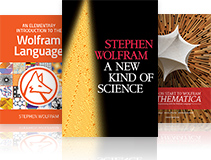Paul Abbott
Published August 6, 2007
This is a column of programming tricks and techniques, most of which, we hope, will be contributed by our readers, either directly as submissions to The Mathematica Journal or as an edited answer to a question posted in the Mathematica newsgroup, comp.soft-sys.math.mathematica. Read More »
B E Y O N D S U D O K U
Ed Pegg Jr
Published August 6, 2007
Sudoku is just one of hundreds of great puzzle types. This column presents obscure logic puzzles of various sorts and challenges the readers to solve the puzzles in two ways: by hand and with Mathematica. For the latter, solvers are invited to send their code to edp@wolfram.com. The person submitting the most elegant solution will receive a prize. Read More »
Eric W. Weisstein
Published August 6, 2007
MathWorld (mathworld.wolfram.com) is the internet’s most popular mathematical resource. Its extensive and detailed entries usually find their way into the top three (if not top one) results returned by a Google search for mathematics terms. Mathematica has long been instrumental in the authoring of MathWorld, which has been hosted by Wolfram Research since 1999. As a result of new work partially funded by a grant from the National Science Digital Library program of the National Science Foundation, MathWorld‘s contents are now written entirely in notebooks that are converted to web pages by Mathematica itself. In this article, the processes that bring MathWorld from keyboard to the web will be discussed, focusing especially on the Mathematica-based tools that make this transformation possible. In addition, a number of useful, new interactive features added to MathWorld as a part of the digital library work will be discussed. Read More »
Dale Olivier Roberts, Alexander Novikov
Published August 6, 2007
In this article we consider both European and discretely monitored exotic options (Bermudan and discrete barrier) in a market where the underlying asset follows a geometric Lévy process. First, we briefly introduce this extended framework. Then, using the variance gamma model, we show how to price European options and demonstrate the application of the recursive quadrature method to Bermudan and discrete barrier options. Read More »
Seth J. Chandler
Published August 6, 2007
This article begins a program of research examining the network structure of precedent-based judicial decision making, using the United States Supreme Court as an initial example. It develops a set of Mathematica tools that facilitate studies of large networks, including vehicles for Mathematica to communicate with external network analysis software. Read More »
Peter Falloon
Published August 6, 2007
We present a simple method for solving scattering problems with multiple incoming and outgoing channels and demonstrate its application to the problem of conduction through a ferromagnetic domain wall. Read More »
Neil Riste, Bradley McGrath, Jingbo Wang, Jie Pan
Published August 6, 2007
In this article we develop and implement a split region technique that solves the time-dependent acoustic wave equation with greatly increased efficiency. This method uses a sophisticated Chebyshev propagation scheme in areas where there are interfaces and medium variations, and a simple free space propagator where the medium is homogeneous. Mathematica provides a cohesive and interactive environment, where the mathematical functions and visualization tools required for this work are already built in. The interactive interface allows users to modify the code and study specific problems with ease. Read More »
Oliver Rübenkönig, Zhenyu Liu, Jan G. Korvink
Published August 6, 2007
The IMTEK Mathematica Supplement (IMS) provides the basis for an Integrated Engineering Development Environment (IEDE). In this context we created an open source linear finite element modeling environment comprising the mechanics, fluidics, and a general differential operators domain. We split the operators from the geometry and shape functions, resulting in symbolic operators, which are well suited for finite element code generation, and fast numerical operators. In this article we show how we use the fast numerical operators for analyzing a microelectromechanical system device. A fast transient solution by means of model order reduction is presented. Finally, we conclude with a harmonic analysis. Read More »
Oliver Rübenkönig, Jan G. Korvink
Published August 6, 2007
Mathematica provides a unique capability for interactive learning. The possibility to combine program code and explanations in an interactive environment is well suited for teaching. The Chair of Microsystem Simulation at the University of Freiburg has developed a wide range of interactive simulation tutorials that have been distributed under the GNU Free Documentation License (FDL). The tutorials cover finite difference, finite volume and finite element methods, and multigrid and iterative solvers. Topics such as sparse matrices and derivatives recovery are also explained. Students are led through the topics assuming little or no prior knowledge. We found that the students gained a good understanding by experimenting with available parameters. In a subsequent step the tutorials are used for verifying other program code. Read More »
Kosaku Nagasaka
Published August 6, 2007
Symbolic-Numeric Algebra for Polynomials (SNAP) is a prototype package that includes basic functions for computing approximate algebraic properties, such as the approximate GCD of polynomials. Our aim is to show how the unified tolerance mechanism we introduce in the package works. Using this mechanism, we can carry out approximate calculations under certified tolerances. In this article, we demonstrate the functionality of the currently released package (Version 0.2), which is downloadable from wwwmain.h.kobe-u.ac.jp/~nagasaka/research/snap/index.phtml.en. Read More »






